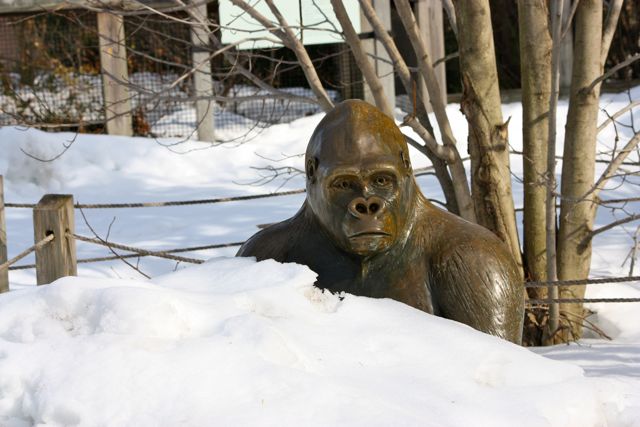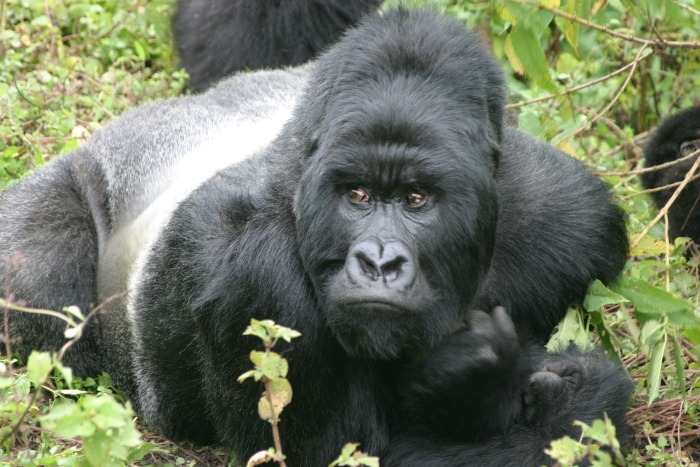The shooting of an endangered gorilla was tragic. Let it also be meaningful.

The one process now going on that will take millions of years to correct
is the loss of genetic and species diversity by the destruction of natural habitats.
This is the folly our descendants are least likely to forgive us.
E. O. Wilson
On Saturday, a little boy infiltrated a gorilla exhibit and consequently a gorilla named Harambe was shot in his own enclosure by zoo officials. I was at the beach with family and not actively monitoring headlines, but I still knew all about it. My timeline was filled with outrage that the decision had been made to kill a rare gorilla rather than tranquilize it.
On Sunday, the information had spread that tranquilization wasn’t really an option because the drugs would take time to take effect and there was no way of knowing how Harambe would react: possibly violently due to the perceived violation, perhaps unpredictably due to the drugs in his system, perhaps clumsily as the drugs took hold. In any case, tranquilizing a gorilla currently holding a little kid is only presenting more danger.
So the outrage shifted: none of this would have happened if not for that kid getting in there in the first place. Where was his mother? Why wasn’t she watching him? How could this have happened?

The internet knew: bad parenting, that’s how. There was lots of finger pointing and cries of neglect. People wanted this mother’s kids taken away. It was mob mentality at its worst.
On Monday, the backlash began. “How can you be so high and mighty and self-righteous?” this new group self-righteously demanded of the parenting critics. They told stories of times they’d lost track of their kids. They reminded everyone that becoming parents doesn’t turn us into super humans, that we all make mistakes. (To be clear, I mostly agree with this group, but holy carp there was a lot of high and mightiness going on.)
On Tuesday, people started posting about Netflix acquiring Disney movies, so, you know, they were distracted. I saw a couple of people grumble that the problem is that gorillas shouldn’t be locked up in zoos anyway, but that was it.
And I patiently waited, scrolling through the think pieces that littered my timeline, for the outrage and the finger pointing and the blame game to die down. Waited for people to start sharing the news that really mattered, that would make Harambe’s death meaningful. And I just haven’t seen them. I’m sure they’re out there, but they couldn’t fight the loudness of the outrage.
So, here we are. I’m writing the post I couldn’t find to share. I’m getting noisy.
Sometimes people just suck
Oh, the outrage. And the outrage at the outrage. And the accusations of being outraged at the wrong things. It’s exhausting and not very productive.
I really couldn’t get over how people were jumping to blame based on a headline they saw, without bothering to click through and read the articles and expert or eyewitness accounts.
I also kind of couldn’t get over the fact that people only cared in this situation because they’d humanized the gorilla; a major sticking point was whether he was protecting the child or no. All gorillas deserve the right to a full life. All animals deserve protection. Many species are crucially in danger of becoming functionally extinct. Can we direct all that outrage and energy there, please?
Sometimes situations just suck
Look. This whole situation was a tragedy, from start to finish, but once that kid got in the enclosure there weren’t a lot of options for a happy outcome. Yes, it all could have been avoided if the mother had kept her son in a vise-like grip once he announced he was going to try to get in the gorilla exhibit, but seriously? We cannot be 100% locked-in on our kids every moment of every day nor should we be.
My son Maverick was a Junior Ambassador for the zoo when he was 9. That meant that he got to wander around the zoo, without adult supervision, before it was open on Saturday mornings, to road test new maps and such and offer feedback. It didn’t occur to me to worry about him wandering into an exhibit; if you’d asked me, I’d have assumed it couldn’t be done.
By the same token, if you’d asked a zoo worker if a four year old could climb in with a gorilla, I’d assume they’d have answered it couldn’t be done. Those exhibits are tiered; there’s a barrier to keep the public on this side and the gorillas on this side and a frigging moat in between. No one anticipated a kid being capable of figuring out how to maneuver his way to the gorillas, having the attention span and will to do so, and being small enough to wiggle through. It was a perfect storm of kid-dom.
Which brings me to my next point.
Never underestimate what kids are capable of
It’s a tragedy and a damned shame that Harambe lost his life because adults didn’t really think through all potentialities and the tenacity of preschool-aged boys. But we can’t possibly plan for every potential outcome and kids are clever, man, they are quick. Don’t talk down to your kids, they are capable of a lot more than you give them credit for.
We need to teach the importance of zoos and proper zoo etiquette
I am not anti-zoo; I am pro humane treatment of animals in captivity. While I don’t love the idea of animals being closed in, I understand and respect the role zoos play in conserving animal populations globally, through breeding programs and education programs.
Our job as parents is to communicate to our kids that the zoo is these animals’ home. They have been displaced from their natural habitat, or maybe they were born into captivity. They are subjected to prying eyes and loud voices all day.
- Tell your kids to respect the animals’ need for privacy, or rest, when they retreat to quiet parts of their enclosure. Help them to develop empathy for the animals.
- Point out, read, obey and enforce signs around the zoo. Most glass-enclosed animals will have a sign posted requesting that you not tap on the glass. Nocturnals might ask that you not take photographs with a flash. And the gorilla exhibit generally warns not to make eye contact, as this is considered aggressive. “No littering” is probably posted everywhere. Talk about why these signs are posted, and what it means for the safety and general well-being of the animals.
- Extend these lessons beyond the zoo by reading more about the animals, by watching documentaries, by looking at pictures. This is how you raise children to love animals, to become future conservationalists.
To love a thing, you have to know it first, and for many kids the zoo is the best way to do that. Zoos are important.

Support your local zoo and conservation programs. Advocate.
An endangered western lowland silverback (mature adult males are called silverbacks), Harambe was one of 353 gorillas being bred in US zoos. His unexpected death has repercussions within the captive gorilla community: he was troop leader to females in his enclosure, and the breeding program will have to adjust for his absence to keep gorilla partnerships compatible yet genetically diverse.
Incidents like this should serve to draw attention to the fact that zoos need more support, not boycotts or calls to cease existing. Zoos do important work: protecting at-risk species, educating the community and allowing zoologists to conduct research to better serve animals in the wild. Support them by visiting them respectfully. Buy a membership, and visit at different times of year and times of day so you can be there at less busy times and see all the animals when they are most active. Attend the zoo’s fundraisers and special events.
Allow your child to get up close and look into the animals’ eyes, when it is safe to do so. Let them forge connections and memories that you can’t through a screen. See if they can become involved in youth zoo programs, like Maverick did. As adults, some of our strongest convictions and basis for action can be traced back to the memories formed from childhood experiences. Give your kids those experiences, empower them to do what they can to help, and model that same behavior by taking your own actions.
Money is the easiest and most helpful way to help animal populations right away, and for gorillas time is critical. There are four subspecies of gorillas: the Eastern lowland (fewer than 5,000 in the wild), the critically Cross River gorilla (less than 300), mountain gorillas (around 700) and around western lowland (150,000-200,000). Putting money in the hands that can help existing gorillas— and other endangered species— is the best way to be useful right now, but the greater threats are habitat loss and climate change. Those are threats that need everyone’s assistance. ADVOCATE. Let people know that you care enough to try to make a difference. Share ways to conserve energy and habitat. “Adopt” a gorilla or a whole mountain gorilla family. Shop on Amazon by starting on the Amazon Smile page, and a portion of what you purchase supports the conservation organization of your choice. Buy sustainable wood. Do what you can.
Every bit helps, but doing nothing helps no one.

photo via gorillas.org
For more info on gorillas, and what you can do to help:
The Gorilla Organization at gorillas.org
The Great Apes Survival Partnership (GRASP) at un-grasp.org
The Dian Fossey Gorilla Fund International at gorillafund.org
The Official Website of Virunga National Park: the only facility in the the world that cares for mountain gorilla orphans. virunga.org
Also, check out the always wonderful Nature from PBS; these are their recent episodes that cover gorillas.












Leave a Reply